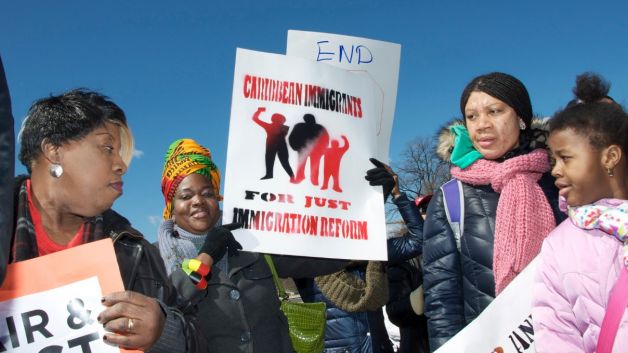News Americas, NEW YORK, NY, Tues. Dec. 16, 2014: For years the question has been asked and left unanswered, but Caribbean Americans may now have a better idea of how many undocumented Caribbean immigrants are living across the length and breadth of the United States.
Thanks to the Pew Hispanic Center’s latest report, based on augmented American Community Survey data from the Integrated Public Use Microdata Series (IPUMS); from research by Robert Warren and John Robert Warren and from the U.S. Immigration and Naturalization Service, the undocumented population of Caribbean immigrants in the U.S. is estimated at around 550,000.
That’s about 100,000 more than undocumented Africans and Middle Eastern immigrants but 100K less than the undocumented population of European and Canadian immigrants living in the U.S.
The Caribbean total undocumented population as of 2012 is, however, only broken down by only three countries – the Dominican Republic, Haiti and Jamaica, sources of the largest numbers of Caribbean migrants to the U.S.
According to the Pew report, ‘Unauthorized Immigrant Population Trends for States, Birth Countries and Regions,’ there are about 170,000 Dominican Republic nationals living without legal work papers in the U.S. while there are reportedly 110,000 Haitians who are considered undocumented.
Jamaicans account for an estimated 100,000 of the unauthorized immigrant population, the Pew data showed.
By contrast, South America has more than 200,000 more undocumented immigrants living in the U.S. than the Caribbean, the statistics show, putting the South American immigrant total at 700,000.
But by far, the largest numbers of undocumented migrants are from Mexico and Central America. There are an estimated 1.7 million Central American living without legal working papers in the U.S. while there are about 5.8 million Mexicans, the Pew data revealed. Most of the Central Americans are reportedly from El Salvador and Guatemala, with 675,000 and 525,000, respectively.
Meanwhile, overall, an estimated 11.2 million unauthorized immigrants lived in the U.S. in 2012, down from a peak of 12.2 million in 2007 and unchanged since 2009. Unauthorized immigrants accounted for 3.5 percent of the 2012 U.S. population of nearly 316 million and 26 percent of the nation’s 42.5 million foreign-born residents, according to the center’s new estimates.
From 2009 to 2012, according to new Pew Research Center estimates, the population of unauthorized immigrants rose in seven states and fell in 14. The population grew in Florida, Maryland, New Jersey, Pennsylvania and Virginia as well as in Idaho and Nebraska, Pew estimates.
But it declined in Massachusetts and New York as well as Arizona, California, Colorado, Nevada, New Mexico, Oregon, Alabama, Georgia, Kentucky, Illinois, Indiana and Kansas.








